中草药有机质谱分析英文论文讲解
mini-reviews in medicinal chemistry引用格式-概述说明以及解释

mini-reviews in medicinal chemistry引用格式-概述说明以及解释1.引言1.1 概述在《mini-reviews in medicinal chemistry》这篇长文中,我们将重点关注当前药物化学领域的研究进展和重要的研究成果。
药物化学是一门研究药物设计、合成和优化的学科,对于新药物的开发和治疗疾病具有重要意义。
本文旨在提供一个概述和综述最新的药物化学领域的相关研究成果,以便读者了解当前这一领域的进展情况。
通过对已有的文献进行综合分析和评价,我们将介绍一些有意义的研究成果和突破性进展,以及它们在药物研发和临床应用中的潜在价值。
本文主要分为三个部分。
第一部分是引言,我们将对药物化学的概念和研究领域进行简要介绍,以便读者对该领域有一个大致的了解。
第二部分是正文,我们将详细探讨几个重要的研究要点,包括药物设计、化合物合成和生物活性评价等方面的内容。
最后一部分是结论,我们将总结本文的主要观点和发现,并探讨未来药物化学研究的发展方向。
通过撰写这篇文章,我们希望能够向读者展示当前药物化学领域的发展动态和重要研究成果,为研究人员提供一个全面了解该领域的概览,以及未来研究方向的指导。
同时,我们也希望能够促进学术界之间的合作与交流,推动药物化学领域的进一步发展和创新。
1.2 文章结构文章结构部分应该包括以下内容:文章的结构是指文章整体的组织方式和框架,有助于读者理解文章的逻辑和脉络。
本文将按照以下结构展开讨论:引言部分:首先对mini-reviews in medicinal chemistry进行简要介绍,介绍该期刊的背景和特点,以及其在医药化学领域的重要性和影响力。
接着,对本文的研究目的进行明确和具体地描述,即在该期刊上撰写一篇长文,从而引出本文的整体框架。
正文部分:本文的正文将以四个要点为主线进行展开。
每个要点将对mini-reviews in medicinal chemistry的某一方面进行详细探讨。
中药鉴别实验英文作文
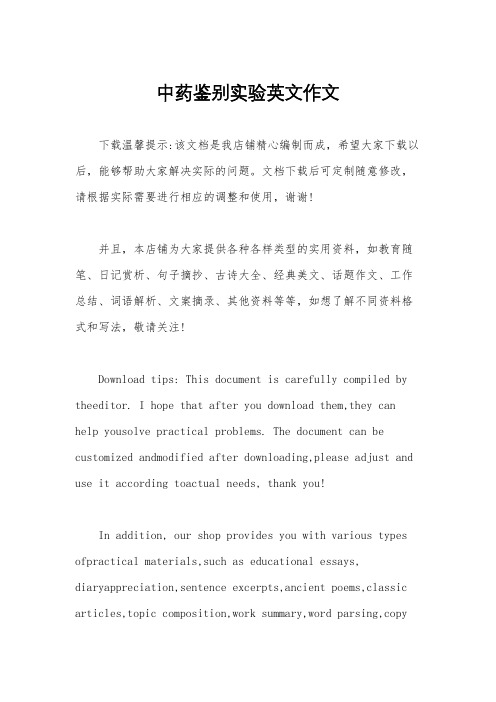
中药鉴别实验英文作文下载温馨提示:该文档是我店铺精心编制而成,希望大家下载以后,能够帮助大家解决实际的问题。
文档下载后可定制随意修改,请根据实际需要进行相应的调整和使用,谢谢!并且,本店铺为大家提供各种各样类型的实用资料,如教育随笔、日记赏析、句子摘抄、古诗大全、经典美文、话题作文、工作总结、词语解析、文案摘录、其他资料等等,如想了解不同资料格式和写法,敬请关注!Download tips: This document is carefully compiled by theeditor. I hope that after you download them,they can help yousolve practical problems. The document can be customized andmodified after downloading,please adjust and use it according toactual needs, thank you!In addition, our shop provides you with various types ofpractical materials,such as educational essays, diaryappreciation,sentence excerpts,ancient poems,classic articles,topic composition,work summary,word parsing,copyexcerpts,other materials and so on,want to know different data formats andwriting methods,please pay attention!I love doing the traditional Chinese medicine identification experiment. It's so interesting to see all those different herbs and try to figure out what they are.In the experiment, we use various methods todistinguish the authenticity and quality of the traditional Chinese medicine. It requires a lot of patience and careful observation.Sometimes it's a bit challenging when we come across some really similar-looking ones. But that's also what makes it exciting.We also learn a lot about the characteristics and properties of different traditional Chinese medicines. It's like opening a whole new world of knowledge.Doing this experiment really makes me appreciate the wisdom and uniqueness of traditional Chinese medicine.。
药用植物中活性成分的高效液相色谱分析研究进展

2、在方剂配伍研究中的应用
Байду номын сангаас
中药经过配伍不仅可以改变药性,还可以提 高药物质量、降低毒副作用。袁海龙等测定了茵 陈蒿汤、桅子不同配伍组方、单味桅子中桅子甙 含量,实验结果表明,配伍可提高有效成分桅子 甙含量,说明配伍有助于提高药物质量。容蓉等 测定了四物汤、白芍不同配伍组方、单味白芍中 有害成分苯甲酸的含量,发现单味白芍中苯甲酸 含量最高,表明配伍有助于降低药物毒副作用。
3、检测器的研究进展
(l)紫外检测器(UvD)和荧光检测器(FLD) (2)电化学检测器(ECD)
(3)核磁共振检测器(NMRD)
(4)化学发光检测器(CLD) (5)蒸发光散射检测器(ELSD) (6)质谱检测器(MSD) (7)示差折光检测器(DRID) (8)其他检测器
6、在药代动力学研究中的应用
中药代谢动力学的研究有助于进一步揭示体 内化学成分与“证”、临床疗效、中药配伍之间 的联系,指导安全、合理、有效使用药物,真正 意义上实行对中药方剂研究、中药质量标准的控 制和中药制剂工艺的优化。Li等建立了一种反相 高效液相色谱法,将原儿茶酸作为内标物,测定 老鼠血浆中的绿原酸。血浆样品中的绿原酸用乙 睛提取,方法的检测限为 0.4ng/mL,测定结果的 精密度和准确度其相对标准偏差RSD分别为3.14 一10.78%和2.20一5.00%。
五、研究结论
综上所述,HPLC技术发展十分迅速,其理论 和应用方面己发展到一个比较成熟的阶段,并且 还在不断被完善和发展,因此它在植物药的发展 及中药现代化研究的进程中起着非常重要的作用。
六、展望
由于中草药不像化学药品那样简单规范,它 们不仅有非常复杂的成分,并且各种成分之间相 互影响和作用,同一成分的分析结果及在生物体 内的药代动力学过程,可能会因母体药材或制剂 配方的改变而受到不同程度的影响。因此,根据 不同的分析对象、目的和要求,对一种成分化合 物建立不同的分析方法或定量标准是十分必要的。 同时也需要利用高新分析技术继续发展更加高效、 灵敏、准确的分析方法。
解析(英文文献)
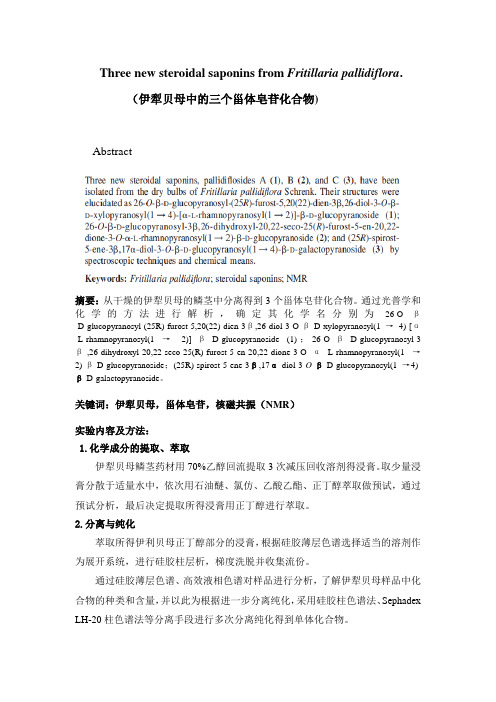
Three new steroidal saponins from Fritillaria pallidiflora.(伊犁贝母中的三个甾体皂苷化合物)Abstract摘要:从干燥的伊犁贝母的鳞茎中分离得到3个甾体皂苷化合物。
通过光普学和化学的方法进行解析,确定其化学名分别为26-O-β-D-glucopyranosyl-(25R)-furost-5,20(22)-dien-3β,26-diol-3-O-β-D-xylopyranosyl(1 →4)-[α-L-rhamnopyranosyl(1 →2)]-β-D-glucopyranoside (1);26-O-β-D-glucopyranosyl-3β,26-dihydroxyl-20,22-seco-25(R)-furost-5-en-20,22-dione-3-O-α-L-rhamnopyranosyl(1 →2)-β-D-glucopyranoside;(25R)-spirost-5-ene-3β,17α-diol-3-O-β-D-glucopyranosyl(1 →4)-β-D-galactopyranoside。
关键词:伊犁贝母,甾体皂苷,核磁共振(NMR)实验内容及方法:1.化学成分的提取、萃取伊犁贝母鳞茎药材用70%乙醇回流提取3次减压回收溶剂得浸膏。
取少量浸膏分散于适量水中,依次用石油醚、氯仿、乙酸乙酯、正丁醇萃取做预试,通过预试分析,最后决定提取所得浸膏用正丁醇进行萃取。
2.分离与纯化萃取所得伊利贝母正丁醇部分的浸膏,根据硅胶薄层色谱选择适当的溶剂作为展开系统,进行硅胶柱层析,梯度洗脱并收集流份。
通过硅胶薄层色谱、高效液相色谱对样品进行分析,了解伊犁贝母样品中化合物的种类和含量,并以此为根据进一步分离纯化,采用硅胶柱色谱法、Sephadex LH-20柱色谱法等分离手段进行多次分离纯化得到单体化合物。
3.结构鉴定通过研究化合物的物理化学性质,化学和UV, IR, NMR, MS等方法对化合物进行结构鉴定。
应用UPLC-Orbitrap质谱分析鲜蟾酥与干蟾酥化学成分差异
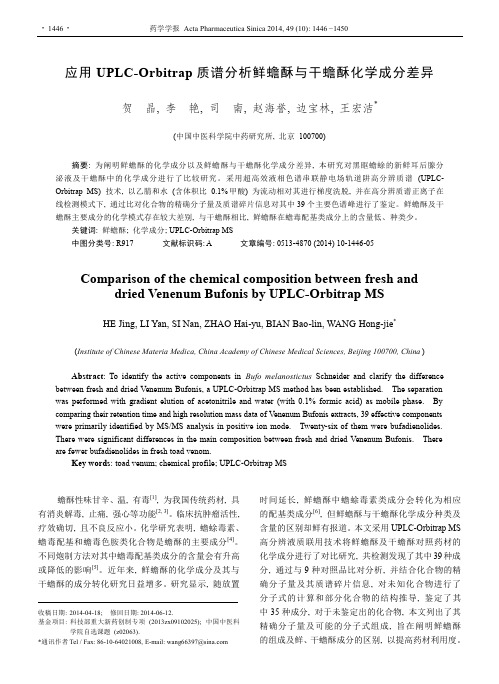
应用UPLC-Orbitrap质谱分析鲜蟾酥与干蟾酥化学成分差异贺晶, 李艳, 司南, 赵海誉, 边宝林, 王宏洁*(中国中医科学院中药研究所, 北京100700)摘要: 为阐明鲜蟾酥的化学成分以及鲜蟾酥与干蟾酥化学成分差异, 本研究对黑眶蟾蜍的新鲜耳后腺分泌液及干蟾酥中的化学成分进行了比较研究。
采用超高效液相色谱串联静电场轨道阱高分辨质谱(UPLC- Orbitrap MS) 技术, 以乙腈和水(含体积比0.1%甲酸) 为流动相对其进行梯度洗脱, 并在高分辨质谱正离子在线检测模式下, 通过比对化合物的精确分子量及质谱碎片信息对其中39个主要色谱峰进行了鉴定。
鲜蟾酥及干蟾酥主要成分的化学模式存在较大差别, 与干蟾酥相比, 鲜蟾酥在蟾毒配基类成分上的含量低、种类少。
关键词: 鲜蟾酥; 化学成分; UPLC-Orbitrap MS中图分类号: R917 文献标识码:A 文章编号: 0513-4870 (2014) 10-1446-05Comparison of the chemical composition between fresh and dried Venenum Bufonis by UPLC-Orbitrap MSHE Jing, LI Yan, SI Nan, ZHAO Hai-yu, BIAN Bao-lin, WANG Hong-jie* (Institute of Chinese Materia Medica, China Academy of Chinese Medical Sciences, Beijing 100700, China)Abstract: To identify the active components in Bufo melanostictus Schneider and clarify the difference between fresh and dried Venenum Bufonis, a UPLC-Orbitrap MS method has been established. The separation was performed with gradient elution of acetonitrile and water (with 0.1% formic acid) as mobile phase. By comparing their retention time and high resolution mass data of Venenum Bufonis extracts, 39 effective components were primarily identified by MS/MS analysis in positive ion mode. Twenty-six of them were bufadienolides. There were significant differences in the main composition between fresh and dried Venenum Bufonis. There are fewer bufadienolides in fresh toad venom.Key words: toad venum; chemical profile; UPLC-Orbitrap MS蟾酥性味甘辛、温, 有毒[1], 为我国传统药材, 具有消炎解毒, 止痛, 强心等功能[2, 3]。
基于LC—MS分析的中药体内成分辨识技术
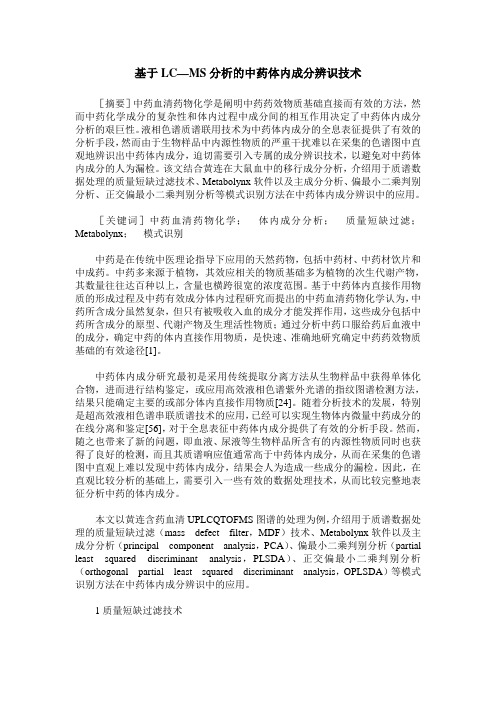
基于LC—MS分析的中药体内成分辨识技术[摘要]中药血清药物化学是阐明中药药效物质基础直接而有效的方法,然而中药化学成分的复杂性和体内过程中成分间的相互作用决定了中药体内成分分析的艰巨性。
液相色谱质谱联用技术为中药体内成分的全息表征提供了有效的分析手段,然而由于生物样品中内源性物质的严重干扰难以在采集的色谱图中直观地辨识出中药体内成分,迫切需要引入专属的成分辨识技术,以避免对中药体内成分的人为漏检。
该文结合黄连在大鼠血中的移行成分分析,介绍用于质谱数据处理的质量短缺过滤技术、Metabolynx软件以及主成分分析、偏最小二乘判别分析、正交偏最小二乘判别分析等模式识别方法在中药体内成分辨识中的应用。
[关键词]中药血清药物化学;体内成分分析;质量短缺过滤;Metabolynx;模式识别中药是在传统中医理论指导下应用的天然药物,包括中药材、中药材饮片和中成药。
中药多来源于植物,其效应相关的物质基础多为植物的次生代谢产物,其数量往往达百种以上,含量也横跨很宽的浓度范围。
基于中药体内直接作用物质的形成过程及中药有效成分体内过程研究而提出的中药血清药物化学认为,中药所含成分虽然复杂,但只有被吸收入血的成分才能发挥作用,这些成分包括中药所含成分的原型、代谢产物及生理活性物质;通过分析中药口服给药后血液中的成分,确定中药的体内直接作用物质,是快速、准确地研究确定中药药效物质基础的有效途径[1]。
中药体内成分研究最初是采用传统提取分离方法从生物样品中获得单体化合物,进而进行结构鉴定,或应用高效液相色谱紫外光谱的指纹图谱检测方法,结果只能确定主要的或部分体内直接作用物质[24]。
随着分析技术的发展,特别是超高效液相色谱串联质谱技术的应用,已经可以实现生物体内微量中药成分的在线分离和鉴定[56],对于全息表征中药体内成分提供了有效的分析手段。
然而,随之也带来了新的问题,即血液、尿液等生物样品所含有的内源性物质同时也获得了良好的检测,而且其质谱响应值通常高于中药体内成分,从而在采集的色谱图中直观上难以发现中药体内成分,结果会人为造成一些成分的漏检。
中药川贝母中脂肪酸成分的GC—MS分析
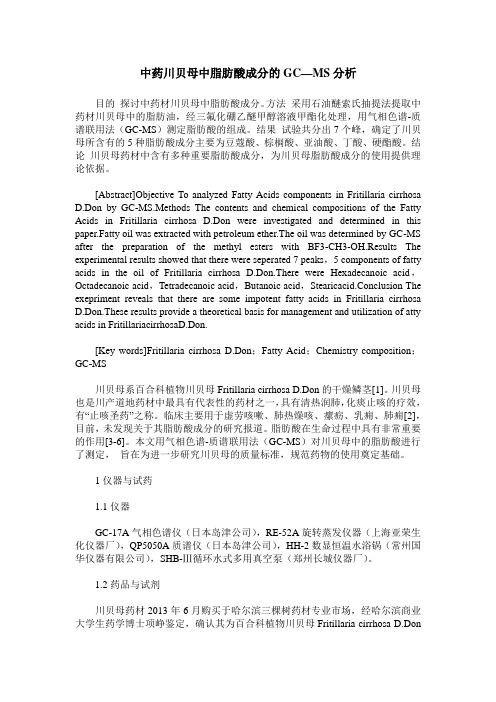
中药川贝母中脂肪酸成分的GC—MS分析目的探讨中药材川贝母中脂肪酸成分。
方法采用石油醚索氏抽提法提取中药材川贝母中的脂肪油,经三氟化硼乙醚甲醇溶液甲酯化处理,用气相色谱-质谱联用法(GC-MS)测定脂肪酸的组成。
结果试验共分出7个峰,确定了川贝母所含有的5种脂肪酸成分主要为豆蔻酸、棕榈酸、亚油酸、丁酸、硬酯酸。
结论川贝母药材中含有多种重要脂肪酸成分,为川贝母脂肪酸成分的使用提供理论依据。
[Abstract]Objective To analyzed Fatty Acids components in Fritillaria cirrhosa D.Don by GC-MS.Methods The contents and chemical compositions of the Fatty Acids in Fritillaria cirrhosa D.Don were investigated and determined in this paper.Fatty oil was extracted with petroleum ether.The oil was determined by GC-MS after the preparation of the methyl esters with BF3-CH3-OH.Results The experimental results showed that there were seperated 7 peaks,5 components of fatty acids in the oil of Fritillaria cirrhosa D.Don.There were Hexadecanoic acid,Octadecanoic acid,Tetradecanoic acid,Butanoic acid,Stearicacid.Conclusion The exepriment reveals that there are some impotent fatty acids in Fritillaria cirrhosa D.Don.These results provide a theoretical basis for management and utilization of atty acids in FritillariacirrhosaD.Don.[Key words]Fritillaria cirrhosa D.Don;Fatty Acid;Chemistry composition;GC-MS川贝母系百合科植物川贝母Fritillaria cirrhosa D.Don的干燥鳞茎[1]。
中药鉴别实验英文作文

中药鉴别实验英文作文英文:As a student of Traditional Chinese Medicine, I havehad the opportunity to learn about the identification of Chinese herbs. In order to identify a herb, we need to observe its characteristics such as its shape, color, texture, and smell. We also need to taste it to determineits flavor and properties.For example, when identifying Radix Astragali (Huang Qi), we observe its long, thin shape, yellowish-white color, and fibrous texture. It has a sweet taste and is slightly warm in nature. This herb is commonly used to tonify the spleen and lungs.Another example is the identification of Radix Salviae Miltiorrhizae (Dan Shen). This herb has a dark red color, a slightly bitter taste, and is slightly cold in nature. Itis commonly used to invigorate blood circulation and treatcardiovascular diseases.中文:作为一名中医学生,我有机会学习中药鉴别。
QuEChERS-超高效液相色谱-串联质谱法同时测定三七中26种真菌毒素

QuEChERS-超高效液相色谱-串联质谱法同时测定三七中26种真菌毒素【摘要】本研究旨在利用QuEChERS-超高效液相色谱-串联质谱法同时测定三七中26种真菌毒素。
通过对三七中真菌毒素的检测,可以保证产品的质量和安全性。
本文首先介绍了QuEChERS方法及超高效液相色谱-串联质谱法的原理和优势,然后阐述了三七中真菌毒素的重要性。
接着详细描述了研究方法与步骤,并对实验结果进行了分析。
最后探讨了QuEChERS-超高效液相色谱-串联质谱法在三七中真菌毒素检测中的应用前景,并展望未来在该领域的研究方向。
通过本研究,为三七产品的质量控制提供了一种快速、准确、高效的检测方法,具有重要的应用价值和发展前景。
【关键词】关键词:QuEChERS, 超高效液相色谱-串联质谱法, 三七, 真菌毒素, 检测, 应用前景, 研究展望1. 引言1.1 研究背景三七是一种常用的中药材,被广泛用于各种疾病的治疗。
由于三七主要生长在湿润的环境中,容易受到真菌的污染,因此三七中可能存在多种真菌毒素。
这些真菌毒素对人体健康造成潜在威胁,因此对三七中的真菌毒素进行快速、准确的检测至关重要。
本研究旨在利用QuEChERS-超高效液相色谱-串联质谱法,同时测定三七中的26种常见真菌毒素,为三七中真菌毒素的快速检测提供新的技术手段。
通过本研究的开展,有望为三七的质量控制和安全性评价提供重要参考,保障三七制品的质量安全。
1.2 研究目的研究目的分为以下几个方面:1. 确定三七中的真菌毒素种类和含量:通过QuEChERS-超高效液相色谱-串联质谱法,可以准确、快速地测定三七中的26种常见真菌毒素,包括黄曲霉素、赭曲霉素、玉米赤霉素等。
研究旨在了解三七中真菌毒素的种类和含量,为保障三七产品的质量安全提供科学依据。
2. 探讨真菌毒素对三七品质的影响:真菌毒素是一类常见的食品污染物,其存在会对食品品质和安全构成潜在威胁。
通过分析真菌毒素在三七中的含量与分布情况,可以探讨真菌毒素对三七品质的影响机制,为制定控制措施提供理论支持。
26911928_UPLC-QQQ-MS

㊀基金项目:辽宁省自然科学基金项目(No.2020-BS-163)ꎻ辽宁省卫计委中医药项目(No.20210506)㊀作者简介:任天航ꎬ男ꎬ研究方向:中药炮制ꎬE-mail:1412972369@qq.com㊀通信作者:刘蓬蓬ꎬ男ꎬ博士研究生ꎬ研究方向:中药炮制ꎬTel:0411-85890135ꎬE-mail:liupengpeng0411@163.comUPLC-QQQ-MS/MS同时测定金银花饮片中核苷类成分的含量任天航ꎬ周正园ꎬ聂紫璇ꎬ王君月ꎬ廉婧ꎬ刘蓬蓬ꎬ史辑(辽宁中医药大学药学院ꎬ国家中医药管理局中药炮制原理解析重点实验室ꎬ辽宁省中药炮制工程技术研究中心ꎬ辽宁大连116600)摘要:目的㊀建立超高效液相色谱-三重四极杆串联质谱(UPLC-QQQ-MS/MS)法比较研究金银花的水提液中核苷类成分的含量ꎮ方法㊀采用WatersBEHC18(2.1mmˑ50mmꎬ1.7μm)色谱柱ꎬ以乙腈(A)-0.1%甲酸水(B)为流动相梯度洗脱ꎬ流速0.4mL min-1ꎬ柱温30ħꎬ进样量3μLꎬ电喷雾离子源(ESI)ꎬ正离子多反应监测模式(MRM)对金银花的水煎液中核苷类成分的含量进行测定ꎮ结果㊀金银花中共检测出尿嘧啶㊁鸟嘌呤㊁黄嘌呤㊁β-胸苷㊁尿苷㊁2ᶄ-脱氧腺苷㊁2ᶄ-脱氧鸟苷㊁肌苷㊁鸟苷㊁胸腺嘧啶㊁腺苷㊁环磷酸鸟苷等12种核苷类成分ꎬ其中鸟苷和尿苷的含量较高ꎬ胸腺嘧啶㊁腺苷㊁环磷酸鸟苷的含量由于过低而未展示ꎬ其余9种核苷类成分在测定质量浓度范围内线性关系良好(rȡ0.9990)ꎬ方法精密度㊁重复性和稳定性的RSD值均小于3.0%ꎬ平均加样回收率在99.4%~102.1%ꎬRSD在1.7%~2.7%ꎮ结论㊀该方法准确㊁可靠ꎬ适用于同时测定金银花饮片中核苷类成分的含量ꎬ可用于金银花饮片的质量控制ꎮ关键词:金银花ꎻ核苷ꎻ超高效液相色谱-三重四极杆串联质谱ꎻ含量测定中图分类号:R927.2㊀文献标识码:A㊀文章编号:2095-5375(2022)04-0225-005doi:10.13506/j.cnki.jpr.2022.04.004SimultaneousdeterminationofnucleosidescontentsinhoneysuckledecoctionpiecesbyUPLC-QQQ-MS/MSRENTianhangꎬZHOUZhengyuanꎬNIEZixuanꎬWANGJunyueꎬLIANJingꎬLIUPengpengꎬSHIJi(ChineseMateriaMediaProcessingEngineeringCenterofLiaoningProvinceꎬKeyLaboratoryofProcessingTheoryAnalysisꎬNationalAdministrationofTCMꎬSchoolofPharmacyꎬLiaoningUniversityofTraditionalChineseMedicineꎬDalian116600ꎬChina)Abstract:Objective㊀ToestablishanUPLC-QQQ-MS/MSmethodtocomparethecontentsofnucleosidesinthede ̄coctionofhoneysuckle.Methods㊀WatersBEHC18column(2.1mmˑ50mmꎬ1.7μm)withgradientelutionofacetonitrile(A)-0.1%formicacidinwater(B)wereadopted.Theflowratewas0.4mL min-1.Thecolumntemperaturewas30ħ.Theinjectionvolumewas3μL.Thecontentofnucleosidesinthedecoctionofhoneysucklewasdeterminedbypositiveelectros ̄prayionizationmodeandmultiplereactionmonitoring(MRM).Results㊀12nucleosidecompoundssuchastheuracilꎬgua ̄nineꎬxanthineꎬbeta-thymidineꎬuridineꎬ2ᶄ-deoxyadenosineꎬ2ᶄ-deoxyguanosineꎬinosineꎬguanosineꎬthymineꎬadenosineꎬcyclicguanosinemonophosphateweredetectedinhoneysuckleꎬamongthemthecontentofguanosineanduridinearehigher.Duetothelowcontentofthymineꎬadenosineꎬandcyclicguanosinemonophosphatewerenottoshow.Theother9nucleosidesshowedgoodlinearity(rȡ0.9990)ꎬandtheRSDoftheprecisionꎬrepeatabilityꎬandstabilitytestswerelessthan3.0%.Theaveragerecoveryrateswereat99.4%~102.1%ꎬandRSDwereat1.7%~2.7%.Conclusion㊀Thismethodwasaccurateꎬre ̄liableandsuitableforsimultaneousdeterminationofnucleosidescontentsꎬandcanbeusedforqualitycontrolofhoneysuckledecoctionpieces.Keywords:HoneysuckleꎻNucleosidesꎻUPLC-QQQ-MS/MSꎻDetermination㊀㊀金银花为忍冬科植物忍冬(LonicerajaponicaThunb.)的干燥花蕾或带初开的花ꎬ夏初花开放前采收ꎬ干燥ꎬ具有清热解毒㊁疏散风热之功效ꎬ可用于痈肿疔疮㊁热毒血痢㊁风热感冒等症的治疗[1]ꎮ金银花主要分布于我国山东㊁河南等地ꎬ药理学研究发现ꎬ金银花具有抗炎㊁抗病毒㊁抗氧化㊁保肝等药效作用ꎬ其主要含有的化学成分包括黄酮类㊁皂苷类㊁环烯醚萜类㊁挥发油等[2-3]ꎮ而有关金银花中核苷类成分的研究近年来报道较少ꎬ核苷类成分是维持生命活动的重要活性物质ꎬ经药效学研究发现ꎬ具有抗病毒㊁抗肿瘤㊁抗血小板聚集等多种功效[4-6]ꎮ王芳等[7]首次从金银花中分离鸟苷㊁5-甲氧基尿嘧啶等核苷类成分ꎬ此后有关金银花核苷类成分报道较少ꎬ故本研究将采用超高效液相色谱-三重四极杆串联质谱(UPLC-QQQ-MS/MS)技术ꎬ建立同时测定金银花饮片水提液中核苷类成分含量的方法ꎬ并比较研究不同道地产地金银花饮片水提液中核苷类成分含量的差异ꎬ为金银花饮片的生产加工和提高质量评价标准提供参考依据ꎮ1㊀仪器与试药1.1㊀仪器㊀ACQUITYH-CLASS型UPLC仪(包括二极管阵列检测器㊁二元高压泵㊁在线脱气装置㊁自动进样器㊁柱温箱ꎬ数据采集与处理采用MassLnx软件)和XEVOTQD型MS仪均购自美国Waters公司ꎻMettlerAE240型十万分之一分析天平(瑞士Mettler公司)ꎻDHF-200型手提式高速万能打粉机(温岭市林大机械有限公司)ꎻFA1004B型电子天平(上海精密科学仪器有限公司)ꎻKQ-250DB型数控超声波清洗器(昆山市超声仪器有限公司)ꎻMilli-Q纯水仪(美国Millipore公司)ꎮ1.2㊀试药㊀金银花饮片5批购自河南㊁河北㊁山东㊁安徽等地ꎻ对照品尿嘧啶㊁鸟嘌呤㊁黄嘌呤㊁β-胸苷㊁尿苷㊁2ᶄ-脱氧腺苷㊁2ᶄ-脱氧鸟苷㊁肌苷㊁鸟苷(成都德思特生物技术有限公司ꎬ批号:DSTDN009201㊁DST201009-046㊁DST201025-195㊁DST201103-093㊁DSTDN003401㊁DST200922-143㊁DSTDJ010901㊁DST201029-029㊁DST201029-029ꎬ纯度均不低于98%)ꎻ乙腈㊁甲酸为质谱纯ꎬ水为超纯水ꎬ其他试剂均为分析纯ꎮ2㊀方法与结果2.1㊀分析条件[8-9]2.1.1㊀色谱条件㊀WatersBEHC18(2.1mmˑ50mmꎬ1.7μm)色谱柱ꎻ流动相:乙腈(A)-0.1%甲酸水(B)ꎬ梯度洗脱(0~3minꎬ20%Bң25%Bꎻ3~5minꎬ25%Bң45%Bꎻ5~6minꎬ45%Bң60%Bꎻ6~6.5minꎬ60%Bң20%Bꎻ6.5~10minꎬ20%B)ꎻ流速:0.4mL min-1ꎻ柱温:30ħꎻ进样量:3μLꎮ2.1.2㊀质谱条件㊀采用电喷雾离子源(ESI)ꎬ正离子多反应检测(MRM)模式ꎮ毛细管电压:3.0kVꎻ离子源温度150ħꎻ脱溶剂气N2ꎬ脱溶剂气流量1000L h-1ꎻ脱溶剂温度:500ħꎮ9种核苷成在MRM模式下的色谱保留时间和具体质谱参数见表1ꎬ全扫描质谱图见图1~9ꎬMRM离子色谱图见图10~18ꎮ表1㊀优化的质谱条件参数化合物保留时间tR/min母离子(m/z)子离子(m/z)锥孔电压/V碰撞能量/eV尿嘧啶0.98113.03-3438鸟嘌呤2.08152.05-4240黄嘌呤1.29153.04109.973652β-胸苷0.92243.09127.09138尿苷1.23245.07113.0418102ᶄ-脱氧腺苷1.50252.10136.1224152ᶄ-脱氧鸟苷1.60268.10152.121712肌苷1.48269.08137.111610鸟苷1.93284.09152.114014图1㊀尿嘧啶质谱图图2㊀鸟嘌呤质谱图图3㊀黄嘌呤质谱图图4㊀β-胸苷质谱图图5㊀尿苷质谱图图6㊀2ᶄ-脱氧腺苷质谱图图7㊀2ᶄ-脱氧鸟苷质谱图图8㊀肌苷质谱图图9㊀鸟苷质谱图图10㊀尿嘧啶MRM离子色谱图图11㊀鸟嘌呤MRM离子色谱图图12㊀黄嘌呤MRM离子色谱图图13㊀β-胸苷MRM离子色谱图图14㊀尿苷MRM离子色谱图图15㊀2ᶄ-脱氧腺苷MRM离子色谱图图16㊀2ᶄ-脱氧鸟苷MRM离子色谱图图17㊀肌苷MRM离子色谱图图18㊀鸟苷MRM离子色谱图2.2㊀溶液的制备2.2.1㊀对照品溶液的制备㊀精密称取尿嘧啶㊁鸟嘌呤㊁黄嘌呤㊁β-胸苷㊁尿苷㊁2ᶄ-脱氧腺苷㊁2ᶄ-脱氧鸟苷㊁肌苷㊁鸟苷的对照品适量ꎬ分别置于10mL量瓶中ꎬ鸟嘌呤加入0.1mol L-1盐酸溶液ꎬ黄嘌呤加入0.1%氢氧化钾溶液ꎬ其他对照品加入超纯水溶解ꎬ室温定容ꎬ均配制成单一对照品溶液ꎬ4ħ冰箱储存备用ꎮ2.2.2㊀样品溶液的制备㊀取样品0.5gꎬ精密称定ꎬ置于具塞锥形瓶中ꎬ精密加入超纯水20mLꎬ称量ꎬ密封冷藏过夜ꎬ超声提取(250Wꎬ40kHz)60minꎬ放冷至室温ꎬ用超纯水补足减失的量ꎬ离心ꎬ取上清液用0.22μm微孔滤膜滤过ꎬ即得供试品溶液ꎬ置于冰箱4ħ储存备用[10-11]ꎮ2.3㊀方法学考察2.3.1㊀线性关系考察㊀精密吸取 2.2.1 项下对照品储备液适量ꎬ逐级稀释得到5个不同浓度的系列对照品溶液ꎬ在 2.1.1 和 2.1.2 项下条件进样分析ꎬ以对照品的质量浓度X(μg mL-1)为横坐标ꎬ以相应的峰面积Y为纵坐标ꎬ进行线性回归ꎬ回归方程㊁相关系数和线性范围见表2ꎻ分别以各成分标准品的信噪比(S/N)等于3和10时所对应的浓度定为检测限(LOD)和定量限(LOQ)ꎬ结果见表2ꎮ2.3.2㊀精密度试验㊀精密吸取 2.2.1 项下对照品储备液适量混合ꎬ按 2.1.1 和 2.1.2 项下条件进样分析ꎬ连续进样6次ꎮ结果显示ꎬ尿嘧啶㊁鸟嘌呤㊁黄嘌呤㊁β-胸苷㊁尿苷㊁2ᶄ-脱氧腺苷㊁2ᶄ-脱氧鸟苷㊁肌苷㊁鸟苷峰面积的RSD值分别为1.1%㊁1.3%㊁1.1%㊁1.5%㊁1.2%㊁1.9%㊁1.4%㊁1.2%㊁1.5%ꎬ表明该仪器精密度良好ꎮ2.3.3㊀重复性试验㊀精密称取同一批金银花样品6份ꎬ按 2.2.2 项下方法制备供试品溶液ꎬ然后按 2.1.1 和 2.1.2 项下条件进行分析并计算各成分的质量分数ꎮ结果显示ꎬ尿嘧啶㊁鸟嘌呤㊁黄嘌呤㊁β-胸苷㊁尿苷㊁2ᶄ-脱氧腺苷㊁2ᶄ-脱氧鸟苷㊁肌苷㊁鸟苷峰质量分数的RSD值分别为2.1%㊁1.8%㊁1.6%㊁2.5%㊁2.2%㊁1.9%㊁2.4%㊁1.8%㊁2.1%ꎬ表明该方法重复性良好ꎮ2.3.4㊀稳定性试验㊀精密吸取同一份金银花的样品溶液ꎬ按 2.1.1 和 2.1.2 项下条件ꎬ分别于0㊁4㊁8㊁10㊁12㊁24h进样测定ꎬ测得尿嘧啶㊁鸟嘌呤㊁黄嘌呤㊁β-胸苷㊁尿苷㊁2ᶄ-脱氧腺苷㊁2ᶄ-脱氧鸟苷㊁肌苷㊁鸟苷质量分数的RSD值分别为1.2%㊁1.1%㊁1.4%㊁1.2%㊁1.5%㊁0.9%㊁1.3%㊁1.1%㊁1.6%ꎬ表明供试品溶液在24h内稳定性良好ꎮ2.3.5㊀加样回收率试验㊀精密称定同一批已知含量的金银花样品6份ꎬ加入适量各对照品溶液ꎬ按 2.2.2 项下方法制备供试品溶液ꎬ然后按 2.1.1 和 2.1.2 项下条件进行测定ꎬ记录各成分的峰面积并计算加样回收率ꎮ结果显示ꎬ尿嘧啶㊁鸟嘌呤㊁黄嘌呤㊁β-胸苷㊁尿苷㊁2ᶄ-脱氧腺苷㊁2ᶄ-脱氧鸟苷㊁肌苷㊁鸟苷的平均加样回收率分别为100.5%㊁102.1%㊁99.4%㊁101.2%㊁100.5%㊁99.9%㊁100.3%㊁102.1%㊁99.6%ꎬRSD值分别为1.7%㊁1.9%㊁2.4%㊁2.2%㊁2.5%㊁2.5%㊁2.7%㊁2.1%㊁2.6%ꎮ表2㊀线性方程㊁线性范围㊁相关系数㊁LOD和LOQ化合物回归方程r线性范围/μg mL-1LOD/ng mL-1LOQ/ng mL-1尿嘧啶Y=11849601.9942X+100.94680.99940.02~0.433.6512.17鸟嘌呤Y=8392814.9839X-159.31870.99910.02~0.3910.4934.92黄嘌呤Y=28525189.5690X-340.09370.99900.03~0.538.0726.74β-胸苷Y=22221890.7624X+1055.27870.99900.06~2.577.7125.31尿苷Y=19365275.3520+22320.72860.99910.18~35.5010.6635.542ᶄ-脱氧腺苷Y=115464733.1560X+47.65140.99970.01~0.272.578.862ᶄ-脱氧鸟苷Y=46258786.7703X-23.83430.99980.06~2.435.3317.69肌苷Y=62195410.0337X-224.89270.99950.02~0.497.1723.21鸟苷Y=3008573.9520X+7011.95680.99980.26~262.000.582.062.4㊀样品测定㊀准确称取5批样品ꎬ按 2.2.2 项下方法制备供试样品溶液ꎬ按 2.1.1 和 2.1.2 项下条件测定ꎬ总离子流图见图19ꎬ结果见表3ꎮ图19㊀河南新乡样品总离子流图表3㊀5批样品中9种核苷成分含量(μg g-1ꎬn=3)化合物河南新乡河南封丘山东临沂安徽亳州河北保定尿嘧啶2.312.311.212.030.80鸟嘌呤14.5313.5611.8210.8212.11黄嘌呤5.108.733.232.702.79β-胸苷5.824.794.324.073.37尿苷682.32752.25615.56676.11817.182ᶄ-脱氧腺苷0.490.820.440.440.512ᶄ-脱氧鸟苷19.1623.6818.3717.4220.05肌苷7.957.048.677.887.63鸟苷8360.328684.457520.227728.399937.623 讨论本试验结果表明ꎬ金银花水提液中的核苷类成分主要为尿嘧啶㊁鸟嘌呤㊁黄嘌呤㊁β-胸苷㊁尿苷㊁2ᶄ-脱氧腺苷㊁2ᶄ-脱氧鸟苷㊁肌苷㊁鸟苷等ꎬ尤以鸟苷和尿苷含量较高ꎮ此外ꎬ金银花水提液中尚含有胸腺嘧啶㊁腺苷㊁环磷酸鸟苷等ꎬ但上述3种成分的含量远低于检测的线性范围ꎬ故未做结果展示ꎮ本研究收集了5批金银花样品ꎬ由结果可见不同区域产的金银花中核苷类成分的含量未见显著差异ꎬ表明河南㊁河北㊁山东㊁安徽等道地产地产的金银花质量较稳定ꎮ并建立了UPLC-QQQ-MS/MS同时测定金银花饮片水提液中核苷类成分含量的方法ꎮ该方法简单㊁快速㊁准确㊁可靠ꎬ可用于金银花的品质鉴定和质量控制ꎮ同时ꎬ亦可为金银花的进一步合理利用与产品开发提供理论支撑ꎮ参考文献:[1]㊀国家药典委员会.中华人民共和国药典2020年版(一部)[S].北京:中国医药科技出版社ꎬ2020.[2]吴娇ꎬ王聪ꎬ于海川.金银花中的化学成分及其药理作用研究进展[J].中国实验方剂学杂志ꎬ2019ꎬ25(4):225-234.[3]刘玉峰ꎬ李鲁盼ꎬ马海燕ꎬ等.金银花化学成分及药理作用的研究进展[J].辽宁大学学报(自然科学版)ꎬ2018ꎬ45(3):255-262.[4]黎海灵ꎬ黄艳萍ꎬ周游ꎬ等.鸡桑㊁华桑和桑的根皮中7种核苷类成分的含量测定[J].食品工业科技ꎬ2021ꎬ42(19):298-306.[5]邓雨果ꎬ黄子健.核苷类似物治疗宫颈人乳头瘤病毒感染的疗效[J].广州医药ꎬ2021ꎬ52(2):11-16. [6]赵从琪ꎬ羊顺波ꎬ李光达ꎬ等.HPLC法测定美洲大蠊药材中五种核苷类成分含量[J].昆明医科大学学报ꎬ2021ꎬ42(2):13-17.[7]王芳ꎬ蒋跃平ꎬ王晓良ꎬ等.金银花的化学成分研究[J].中国中药杂志ꎬ2013ꎬ38(9):1378-1385.[8]葛琦ꎬ万晶琼ꎬ朱益灵ꎬ等.金蝉花核苷类成分的LC-MS定性分析与HPLC含量测定[J].天然产物研究与开发ꎬ2019ꎬ31(11):1857-1863.[9]薛亚甫ꎬ吴蕾蕾ꎬ张倩ꎬ等.北虫草中6种核苷类成分的含量测定与质量控制[J].中国新药与临床杂志ꎬ2016ꎬ35(11):796-802.[10]王胜男ꎬ华愉教ꎬ邹立思ꎬ等.不同 发汗 条件加工玄参中核苷类成分的含量测定及灰色关联度分析[J].药物分析杂志ꎬ2016ꎬ36(6):1027-1036.[11]罗益远ꎬ刘娟秀ꎬ刘训红ꎬ等.不同加工方法中何首乌核苷类成分的含量测定及主成分分析[J].药物分析杂志ꎬ2015ꎬ35(8):1474-1482.(上接第224页)[11]秦宇雯ꎬ张丽萍ꎬ赵祺ꎬ等.九蒸九晒黄精炮制工艺的研究进展[J].中草药ꎬ2020ꎬ51(21):5631-5637.[12]郑晓倩ꎬ金传山ꎬ张亚中ꎬ等.黄精九蒸九晒炮制过程中糖类成分动态变化[J].中成药ꎬ2020ꎬ42(7):1837-1841.[13]宋艺君ꎬ郭涛ꎬ周晓程.不同产地黄精经不同方法炮制后多糖㊁5-羟甲基糠醛的含量变化[J].中国药房ꎬ2017ꎬ28(16):2256-2258.[14]韩笑ꎬ匡宇ꎬ赵永艳ꎬ等.九蒸九晒黄精5-HMF含量的变化[J].中药与临床ꎬ2018ꎬ9(3):4-5.[15]胡叶青ꎬ胡云飞ꎬ吴其国.九华黄精九蒸九晒炮制过程中总多糖的含量变化研究[J].佛山科学技术学院学报(自然科学版)ꎬ2019ꎬ37(6):58-62.[16]国家药典委员会.中华人民共和国药典2020年版(一部)[S].北京:中国医药科技出版社ꎬ2020:319-320. [17]陈丽霞ꎬ王建科ꎬ耿晓玲.综合评分法优选黄精蒸制工艺[J].微量元素与健康研究ꎬ2017ꎬ34(5):38-40. [18]常亮ꎬ陈珍珍ꎬ王栋ꎬ等.HPLC和GC-MS法测定三种黄精炮制过程中5-羟甲基糠醛的含量[J].中国药师ꎬ2015ꎬ18(3):387-390.[19]姜程曦ꎬ张铁军ꎬ陈常青ꎬ等.黄精的研究进展及其质量标志物的预测分析[J].中草药ꎬ2017ꎬ48(1):1-16.。
UPLC-MS法测定丹参药品中水溶性成分含量毕业论文
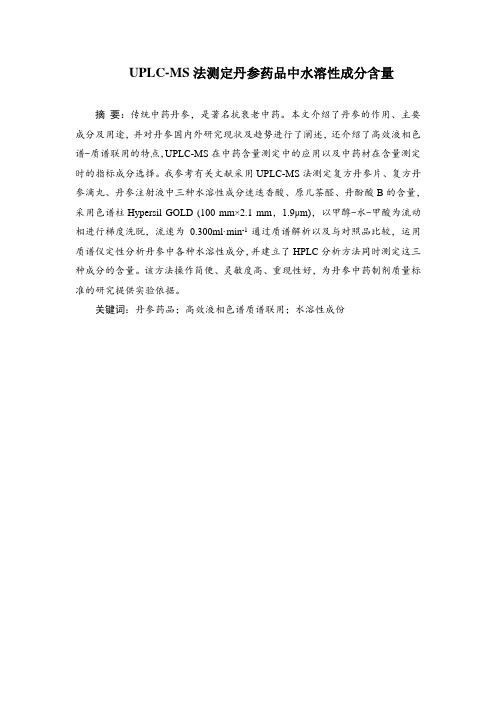
UPLC-MS法测定丹参药品中水溶性成分含量摘要:传统中药丹参,是著名抗衰老中药。
本文介绍了丹参的作用、主要成分及用途,并对丹参国内外研究现状及趋势进行了阐述,还介绍了高效液相色谱-质谱联用的特点,UPLC-MS在中药含量测定中的应用以及中药材在含量测定时的指标成分选择。
我参考有关文献采用UPLC-MS法测定复方丹参片、复方丹参滴丸、丹参注射液中三种水溶性成分迷迭香酸、原儿茶醛、丹酚酸B的含量,采用色谱柱Hypersil GOLD (100 mm×2.1 mm,1.9μm),以甲醇-水-甲酸为流动相进行梯度洗脱,流速为0.300ml·min-1通过质谱解析以及与对照品比较,运用质谱仪定性分析丹参中各种水溶性成分,并建立了HPLC分析方法同时测定这三种成分的含量。
该方法操作简便、灵敏度高、重现性好,为丹参中药制剂质量标准的研究提供实验依据。
关键词:丹参药品;高效液相色谱质谱联用;水溶性成份UPLC - MS Method for Determination of Water-soluble Components in Salvia Miltiorrhiza and Drug IngredientsAbstract: Traditional Chinese medicine danshen, is famous anti-aging medicine. This paper introduces the function, the main ingredient of salvia miltiorrhiza and USES, and the domestic and foreign research present situation and trend of salvia miltiorrhiza, high performance liquid chromatography - mass spectrometry is introduced in the paper, the characteristics of the application of UP LC - MS in content of traditional Chinese medicine (TCM) and Chinese herbal medicine in the choice of indicator elements in the content determination.My reference literatures UP LC - MS method is used to determine the effect, compound danshen dropping pill, three kinds of water-soluble components in salvia miltiorrhiza injection rosemary acid, protocatechuic aldehyde, Dan phenolic acids content of B, the chromatographic column is 100 mm x 2.1 mm, 1.9 mu m model, with methanol - water - formic acid as mobile phase gradient elution, flow rate of 0.300 ml, min - 1 by mass spectrum analysis, and comparison with the reference substance, using qualitative analysis all kinds of water soluble constituents of salvia miltiorrhiza mass spectrometer and to establish the HPLC analysis method for determine the content of these three components simultaneously.The method is simple, high sensitivity, good reproducibility, to the research of salvia miltiorrhiza quality standards of TCM and to provide experimental basis.Key words: Danshen medicines;Water-soluble components;UPLC-MS目录摘要 (x)Abstract (x)第一章前言 (x)1本论文内容 (x)2研究的目的 (x)2.1 研究的背景和意义 (x)2.2 研究的创新点及难点……………………………………………………………3丹参概述 (x)3.1 丹参的介绍 (x)形态特征………………………………………………………………………生境分布………………………………………………………………………化学成分………………………………………………………………………3.2 丹参的功效及作用 (x)3.3 丹参的发展及研究现状 (x)4主要成分提取和分离的方法 (x)4.1 醇提法 (x)4.2 CO超临界流体萃取技术 (x)2高速逆流色谱法 (x)4.4 超声波提取法 (x)5 丹参有效成分的测定方法 (x)薄层色谱法 (x)紫外分光光度法 (x)气相色谱法法 (x)高效液相色谱法 (x)高效液相色谱—质谱联用概述 (x)液相色谱-质谱联用仪介绍 (x)5.5.2 液相色谱-质谱联用仪的发展 (x)5.5.3 液相色谱-质谱联用仪的特点 (x)6 HPLC-MS在中药含量测定方面研究状况 (x)已知化合物定性分析及结构鉴定中的应用 (x)未知成分定性分析中的应用 (x)药物代谢中的应用 (x)第二章实验部分 (x)1仪器与试剂 (x)1.1仪器 (x)1.2试剂 (x)2方法 (x)2.1 条件的选择 (x)色谱条件 (x)质谱条件 (x)流速的选择 (x)离子化模式的选择 (x)2.1.5 MS条件的选择 (x)定量离子对的选择 (x)对照品溶液的制备 (x)样品溶液的制备 (x)方法学考察 (x)线性关系试验 (x)精密度 (x)重复性 (x)稳定性 (x)加标回收率 (x)样品含量测定 (x)3 结果与讨论 (x)4 展望 (x)结论 (x)参考文献 (x)致谢 (x)第一章前言1 本论文内容传统中药丹参为唇形科植物丹参Salvia miltiorrhiza Bge.的干燥根及根茎,是著名抗衰老中药。
ICP-MS 在中药材质量评价中的应用
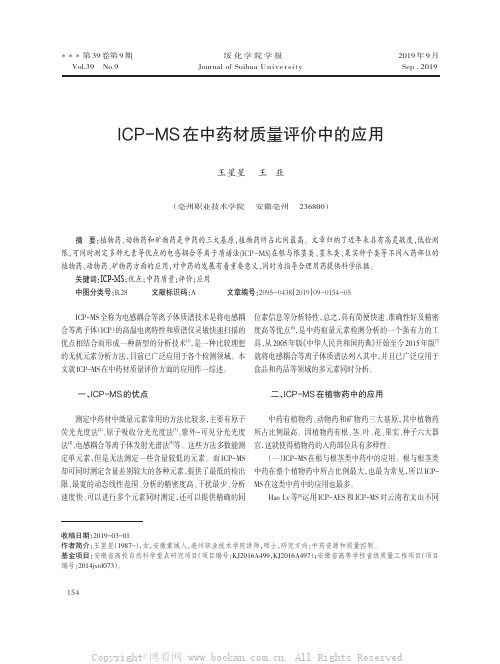
ICP-MS 在中药材质量评价中的应用摘要:植物药、动物药和矿物药是中药的三大基原,植物药所占比例最高。
文章归纳了近年来具有高灵敏度,低检测限,可同时测定多种元素等优点的电感耦合等离子质谱法(ICP-MS)在根与根茎类、茎木类、果实种子类等不同入药部位的植物药、动物药、矿物药方面的应用,对中药的发展有着重要意义,同时为指导合理用药提供科学依据。
关键词:ICP-MS ;优点;中药质量;评价;应用中图分类号:R28文献标识码:A 文章编号:2095-0438(2019)09-0154-05(亳州职业技术学院安徽亳州236800)王星星王亚ICP-MS 全称为电感耦合等离子体质谱技术是将电感耦合等离子体(ICP )的高温电离特性和质谱仪灵敏快速扫描的优点相结合而形成一种新型的分析技术[1],是一种比较理想的无机元素分析方法,目前已广泛应用于各个检测领域。
本文就ICP-MS 在中药材质量评价方面的应用作一综述。
一、ICP-MS 的优点测定中药材中微量元素常用的方法比较多,主要有原子荧光光度法[2]、原子吸收分光光度法[3]、紫外-可见分光光度法[4]、电感耦合等离子体发射光谱法[5]等。
这些方法多数能测定单元素,但是无法测定一些含量较低的元素。
而ICP-MS 却可同时测定含量差别较大的各种元素,提供了最低的检出限、最宽的动态线性范围、分析的精密度高、干扰最少、分析速度快、可以进行多个元素同时测定,还可以提供精确的同位素信息等分析特性,总之,具有简便快速、准确性好及精密度高等优点[6],是中药痕量元素检测分析的一个强有力的工具,从2005年版《中华人民共和国药典》开始至今2015年版[7]就将电感耦合等离子体质谱法列入其中,并且已广泛应用于食品和药品等领域的多元素同时分析。
二、ICP-MS 在植物药中的应用中药有植物药、动物药和矿物药三大基原,其中植物药所占比例最高。
因植物药有根、茎、叶、花、果实、种子六大器官,这就使得植物药的入药部位具有多样性。
中药药效和转录组可以发的英文文章
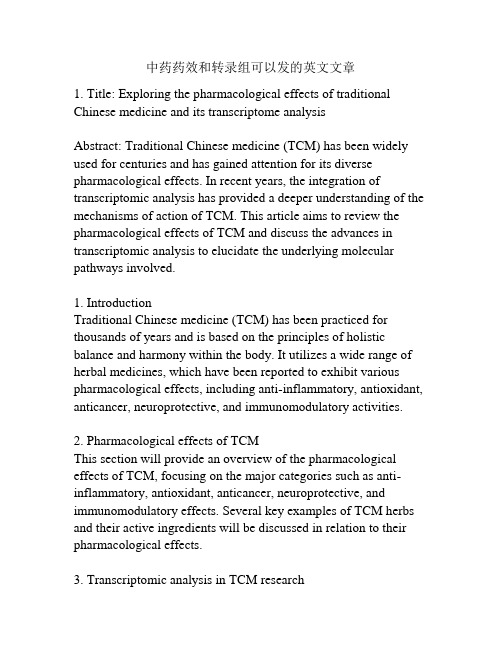
中药药效和转录组可以发的英文文章1. Title: Exploring the pharmacological effects of traditional Chinese medicine and its transcriptome analysisAbstract: Traditional Chinese medicine (TCM) has been widely used for centuries and has gained attention for its diverse pharmacological effects. In recent years, the integration of transcriptomic analysis has provided a deeper understanding of the mechanisms of action of TCM. This article aims to review the pharmacological effects of TCM and discuss the advances in transcriptomic analysis to elucidate the underlying molecular pathways involved.1. IntroductionTraditional Chinese medicine (TCM) has been practiced for thousands of years and is based on the principles of holistic balance and harmony within the body. It utilizes a wide range of herbal medicines, which have been reported to exhibit various pharmacological effects, including anti-inflammatory, antioxidant, anticancer, neuroprotective, and immunomodulatory activities. 2. Pharmacological effects of TCMThis section will provide an overview of the pharmacological effects of TCM, focusing on the major categories such as anti-inflammatory, antioxidant, anticancer, neuroprotective, and immunomodulatory effects. Several key examples of TCM herbs and their active ingredients will be discussed in relation to their pharmacological effects.3. Transcriptomic analysis in TCM researchTranscriptomic analysis, such as RNA sequencing and microarray technology, has emerged as a powerful tool to unravel the molecular mechanisms underlying the pharmacological effects of TCM. This section will provide an overview of the transcriptomic analysis techniques commonly used in TCM research and highlight some notable findings from recent studies.4. Integration of transcriptomic analysis in TCM researchThis section will discuss the integration of transcriptomic analysis with other omics technologies, such as proteomics and metabolomics, to obtain a comprehensive understanding of the molecular changes induced by TCM. Moreover, the challenges and future perspectives of using transcriptomic analysis in TCM research will be discussed.5. ConclusionIn conclusion, TCM has shown diverse pharmacological effects, and recent advances in transcriptomic analysis have provided deeper insights into the underlying molecular mechanisms. Integrating transcriptomic analysis with other omics technologies holds great potential for further elucidating the complexities of TCM and harnessing its therapeutic potentials.Keywords: Traditional Chinese medicine (TCM), pharmacological effects, transcriptomic analysis, RNA sequencing, omics technologies.。
(完整版)三七中甲基对硫磷的提取纯化及气相色谱检测本科毕业论文
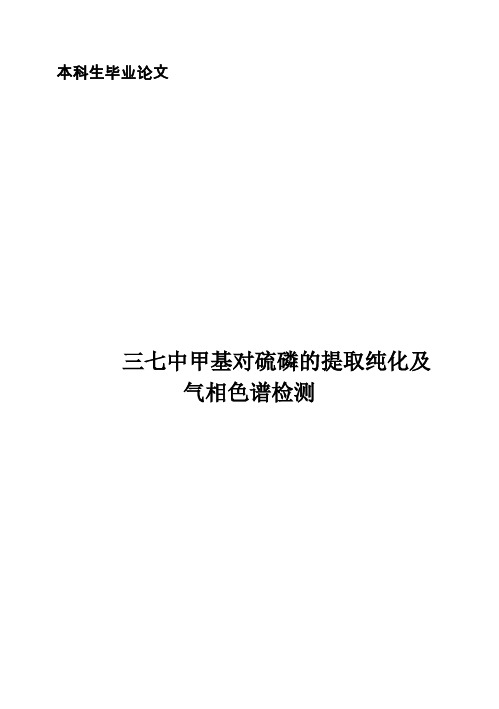
本科生毕业论文三七中甲基对硫磷的提取纯化及气相色谱检测2015 Annual Graduation Thesis (Project) of the College Undergraduate Purification of Acephate and Aetection of Parathion Methyl by Gas ChromatographyDepartment: Department of Chemistry, Collegeof ScienceMajor: ChemistryGrade:2012Student’s Name:Student No.:Tutor:May, 2015毕业论文(设计)原创性声明本人所呈交的毕业论文(设计)是我在导师的指导下进行的研究工作及取得的研究成果。
据我所知,除文中已经注明引用的内容外,本论文(设计)不包含其他个人已经发表或撰写过的研究成果。
对本论文(设计)的研究做出重要贡献的个人和集体,均已在文中作了明确说明并表示谢意。
作者签名:日期:毕业论文(设计)授权使用说明本论文(设计)作者完全了解红河学院有关保留、使用毕业论文(设计)的规定,学校有权保留论文(设计)并向相关部门送交论文(设计)的电子版和纸质版。
有权将论文(设计)用于非赢利目的的少量复制并允许论文(设计)进入学校图书馆被查阅。
学校可以公布论文(设计)的全部或部分内容。
保密的论文(设计)在解密后适用本规定。
作者签名:指导教师签名:日期:日期:毕业论文(设计)答辩委员会(答辩小组)成员名单摘要农药是农业生产的安全卫士,每年使用化学农药为我国粮食产物挽回许多由病虫害而遭到的损失。
农药是农业生产中必不可少的生产资料,保障了我国粮食的供应。
由此可见农药对我们生产生活的重要性。
目前使用最为广泛的是有机磷、有机氯、氨基甲酸酯等为代表的有机类农药。
有机磷杀虫剂是我国稻田最主要的农药,占所有使用农药的70%以上。
毛茛化学成分的hplc、uplcq-tof-ms分析
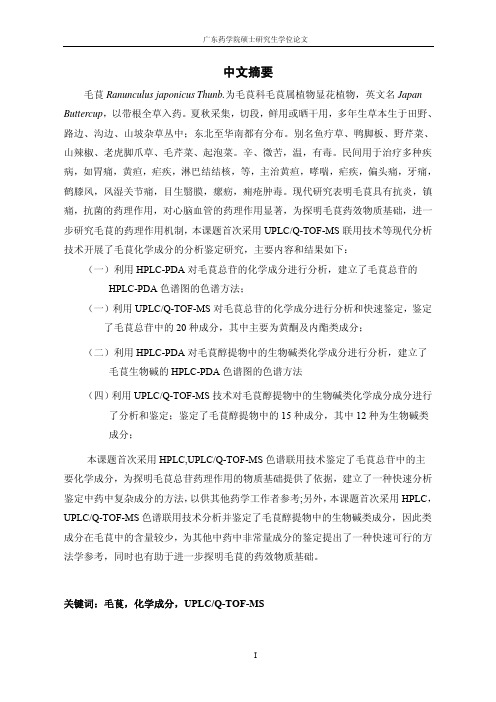
中文摘要毛茛Ranunculus japonicus Thunb.为毛茛科毛茛属植物显花植物,英文名Japan Buttercup,以带根全草入药。
夏秋采集,切段,鲜用或晒干用,多年生草本生于田野、路边、沟边、山坡杂草丛中;东北至华南都有分布。
别名鱼疔草、鸭脚板、野芹菜、山辣椒、老虎脚爪草、毛芹菜、起泡菜。
辛、微苦,温,有毒。
民间用于治疗多种疾病,如胃痛,黄疸,疟疾,淋巴结结核,等,主治黄疸,哮喘,疟疾,偏头痛,牙痛,鹤膝风,风湿关节痛,目生翳膜,瘰疬,痈疮肿毒。
现代研究表明毛茛具有抗炎,镇痛,抗菌的药理作用,对心脑血管的药理作用显著,为探明毛茛药效物质基础,进一步研究毛茛的药理作用机制,本课题首次采用UPLC/Q-TOF-MS联用技术等现代分析技术开展了毛茛化学成分的分析鉴定研究,主要内容和结果如下:(一)利用HPLC-PDA对毛茛总苷的化学成分进行分析,建立了毛茛总苷的HPLC-PDA色谱图的色谱方法;(一)利用UPLC/Q-TOF-MS对毛茛总苷的化学成分进行分析和快速鉴定,鉴定了毛茛总苷中的20种成分,其中主要为黄酮及内酯类成分;(二)利用HPLC-PDA对毛茛醇提物中的生物碱类化学成分进行分析,建立了毛茛生物碱的HPLC-PDA色谱图的色谱方法(四)利用UPLC/Q-TOF-MS技术对毛茛醇提物中的生物碱类化学成分成分进行了分析和鉴定;鉴定了毛茛醇提物中的15种成分,其中12种为生物碱类成分;本课题首次采用HPLC,UPLC/Q-TOF-MS色谱联用技术鉴定了毛茛总苷中的主要化学成分,为探明毛茛总苷药理作用的物质基础提供了依据,建立了一种快速分析鉴定中药中复杂成分的方法,以供其他药学工作者参考;另外,本课题首次采用HPLC,UPLC/Q-TOF-MS色谱联用技术分析并鉴定了毛茛醇提物中的生物碱类成分,因此类成分在毛茛中的含量较少,为其他中药中非常量成分的鉴定提出了一种快速可行的方法学参考,同时也有助于进一步探明毛茛的药效物质基础。
extractable and leachable study drug
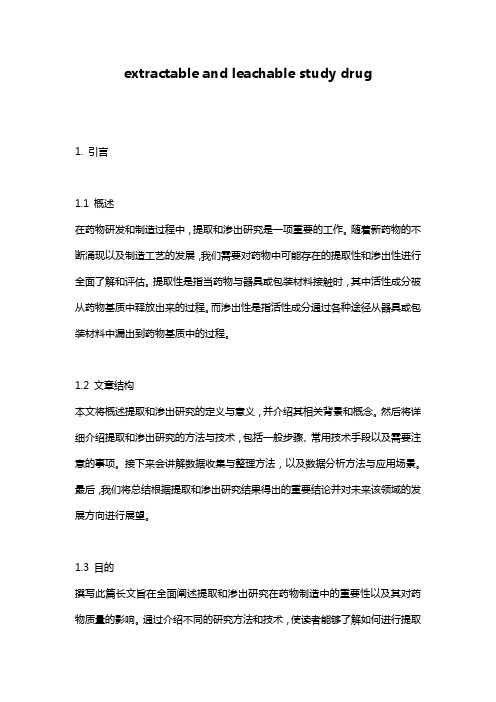
extractable and leachable study drug1. 引言1.1 概述在药物研发和制造过程中,提取和渗出研究是一项重要的工作。
随着新药物的不断涌现以及制造工艺的发展,我们需要对药物中可能存在的提取性和渗出性进行全面了解和评估。
提取性是指当药物与器具或包装材料接触时,其中活性成分被从药物基质中释放出来的过程。
而渗出性是指活性成分通过各种途径从器具或包装材料中漏出到药物基质中的过程。
1.2 文章结构本文将概述提取和渗出研究的定义与意义,并介绍其相关背景和概念。
然后将详细介绍提取和渗出研究的方法与技术,包括一般步骤、常用技术手段以及需要注意的事项。
接下来会讲解数据收集与整理方法,以及数据分析方法与应用场景。
最后,我们将总结根据提取和渗出研究结果得出的重要结论并对未来该领域的发展方向进行展望。
1.3 目的撰写此篇长文旨在全面阐述提取和渗出研究在药物制造中的重要性以及其对药物质量的影响。
通过介绍不同的研究方法和技术,使读者能够了解如何进行提取和渗出研究,并掌握相关数据分析与解读的技巧。
最终,期望能够为未来该领域的发展提供有益的指导和展望。
以上是“1. 引言”部分内容的详细清晰描述。
2. 提取和渗出研究药物的定义与意义2.1 提取和渗出研究的概念与背景提取和渗出研究是一种重要的药物评估方法,旨在评估药物在特定条件下从材料中释放出来(提取)以及进入接触媒介(渗出)的程度。
这种研究可以帮助我们了解药物在实际使用中可能面临的释放和转移情况,尤其对于直接暴露给患者或用户的医疗器械、制剂或包装材料而言尤为重要。
2.2 药物提取性与渗出性的重要性与影响因素药物的提取性指的是药物从材料中释放出来进入接触媒介中的能力。
而渗出性则指药物通过接触媒介传递到其他材料或环境中的能力。
这两个特性直接影响着药物安全性和有效性,对于患者使用体验以及产品质量也具有关键影响。
影响药物提取性和渗出性的因素很多,如材料成分、制备工艺、储存条件、环境因素等。
(综述)植物化学成分及其代谢物的定性和定量分析
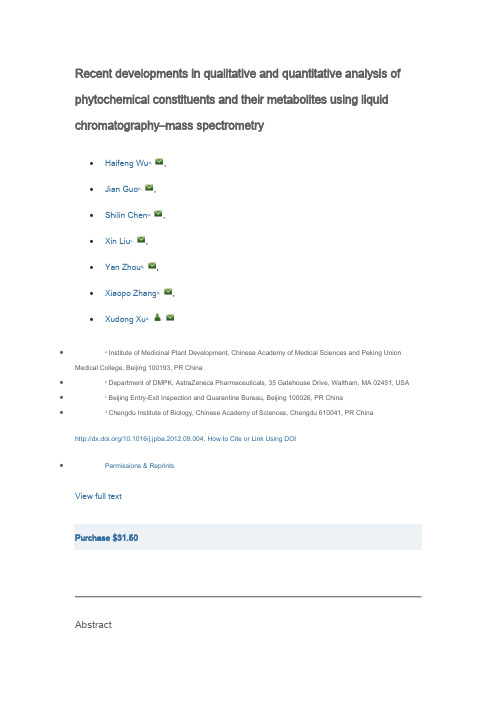
氧杂蒽酮的化学结构(1-15)确定
Figure options
View in workspace
Fig. 2. UHPLC–MS chromatograms of the standard xanthones and the crude extracts of G. hanburyi. (A) UHPLC chromatograms of 12 standard xanthones, (B) TIC of the 12 standard xanthones, (C) UHPLC chromatograms of the crude extracts of G. hanburyi, (D) TIC of the crude extracts of G. hanburyi.
Reproduced with permission from [89]. Figure options
View in workspace
Fig. 5. HSCCC chromatogram of gamboge extract (190 mg). Fraction I (17.26 mg), fr. II (5.48 mg), fr. III (3.81 mg), fr. IV (3.56 mg), fr. V (7.66 mg), fr. VI (3.21 mg), fr. VII (8.21 mg), fr. VIII (35.25 mg), fr. IX (76.78 mg), fr. X (6.04 mg), fr. XI (4.34 mg).
Medical College, Beijing 100193, PR China
b
Department of DMPK, AstraZeneca Pharmaceuticals, 35 Gatehouse Drive, Waltham, MA 02451, USA Beijing Entry-Exit Inspection and Quarantine Bureau, Beijing 100026, PR China Chengdu Institute of Biology, Chinese Academy of Sciences, Chengdu 610041, PR China
关于P450的一篇英文文章翻译

人参皂苷合成途径中催化达玛烯二醇合成原人参二醇的细胞色素P450酶——CYP716A47摘要:人参是一种有名的中药,且在它的根中含有药理活性成分——人参皂苷。
人参皂苷是四环三萜皂苷的一种,被认为是由达玛烯二醇经过细胞色素P450羟化和糖基转移酶糖基化后形成的。
然而,还没有编码羟基化和糖基化的基因被鉴定出来。
本文,我们鉴定了一个原人参二醇合酶,该酶为细胞色素酶,通过对达玛烯二醇的碳12位进行羟化作用形成原人参二醇。
从由茉莉酸甲酯诱导后的人参不定根的EST序列中筛选到9个假定的细胞色素序列。
因为CYP716A47不止在茉莉酸甲酯诱导后表达量提高,且在过表达角鲨烯合酶,皂苷高产的转基因人参中表达量也很高,因此被认为是原人参二醇合酶。
体外实验证明CYP716A47催化达玛烯二醇合成原人参二醇。
在酿酒酵母WAT21中异源表达CYP716A47,可催化达玛烯二醇合成原人参二醇。
另外,在不添加达玛烯二醇的情况下,在酵母中共表达,达玛烯二醇合酶基因和CYP716A47基因,能生成原人参二醇。
由达玛烯二醇形成的原人参二醇结构式通过液相色谱联合大气压化学电离质谱进行分析鉴定。
因此,CYP716A47是一个催化达玛烯二醇合成原人参二醇的达玛烯C12羟化酶。
关键词:CYP716A47;细胞色素P450;达玛烯二醇;人参皂苷;原人参二醇1、前言三萜皂苷是高等植物中异戊二烯类的次生代谢产物。
在不同种类的植物中它表现出结构和生物活性的多样性。
这些分子具有可观的商业价值且很多已被用作药物。
植物中人参皂苷的天然功能被认为可能与防御病原菌和害虫攻击有关。
三萜皂苷的基本骨架有齐墩果烷型,乌苏果烷型,羽扇豆醇型和达玛烷型。
人参因为它对癌症,糖尿病和神经退行性等疾病有显著的药理活性而闻名。
人参皂苷是人参根中的主要生物活性成分。
人参根中至少含有其干重4%的皂苷。
人参皂苷的主要成分是七个达玛烷型的四环三萜皂苷(人参皂苷Rb1, Rb2, Rc, Rd, Re, Rf 和Rg1)和一个含量很少的齐墩果烷型皂苷Ro。
QuEChERS-超高效液相色谱-串联质谱法同时测定三七中26种真菌毒素
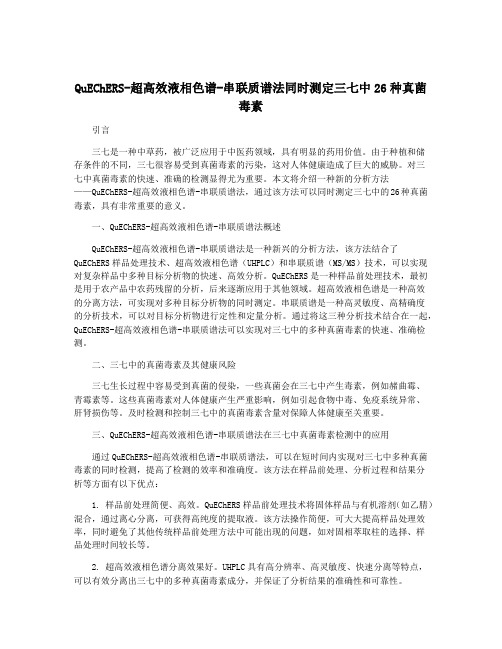
QuEChERS-超高效液相色谱-串联质谱法同时测定三七中26种真菌毒素引言三七是一种中草药,被广泛应用于中医药领域,具有明显的药用价值。
由于种植和储存条件的不同,三七很容易受到真菌毒素的污染,这对人体健康造成了巨大的威胁。
对三七中真菌毒素的快速、准确的检测显得尤为重要。
本文将介绍一种新的分析方法——QuEChERS-超高效液相色谱-串联质谱法,通过该方法可以同时测定三七中的26种真菌毒素,具有非常重要的意义。
一、QuEChERS-超高效液相色谱-串联质谱法概述QuEChERS-超高效液相色谱-串联质谱法是一种新兴的分析方法,该方法结合了QuEChERS样品处理技术、超高效液相色谱(UHPLC)和串联质谱(MS/MS)技术,可以实现对复杂样品中多种目标分析物的快速、高效分析。
QuEChERS是一种样品前处理技术,最初是用于农产品中农药残留的分析,后来逐渐应用于其他领域。
超高效液相色谱是一种高效的分离方法,可实现对多种目标分析物的同时测定。
串联质谱是一种高灵敏度、高精确度的分析技术,可以对目标分析物进行定性和定量分析。
通过将这三种分析技术结合在一起,QuEChERS-超高效液相色谱-串联质谱法可以实现对三七中的多种真菌毒素的快速、准确检测。
二、三七中的真菌毒素及其健康风险三七生长过程中容易受到真菌的侵染,一些真菌会在三七中产生毒素,例如赭曲霉、青霉素等。
这些真菌毒素对人体健康产生严重影响,例如引起食物中毒、免疫系统异常、肝肾损伤等。
及时检测和控制三七中的真菌毒素含量对保障人体健康至关重要。
三、QuEChERS-超高效液相色谱-串联质谱法在三七中真菌毒素检测中的应用通过QuEChERS-超高效液相色谱-串联质谱法,可以在短时间内实现对三七中多种真菌毒素的同时检测,提高了检测的效率和准确度。
该方法在样品前处理、分析过程和结果分析等方面有以下优点:1. 样品前处理简便、高效。
QuEChERS样品前处理技术将固体样品与有机溶剂(如乙腈)混合,通过离心分离,可获得高纯度的提取液。
- 1、下载文档前请自行甄别文档内容的完整性,平台不提供额外的编辑、内容补充、找答案等附加服务。
- 2、"仅部分预览"的文档,不可在线预览部分如存在完整性等问题,可反馈申请退款(可完整预览的文档不适用该条件!)。
- 3、如文档侵犯您的权益,请联系客服反馈,我们会尽快为您处理(人工客服工作时间:9:00-18:30)。
Characterisation of Soy Isoflavones and Screening for Novel Malonyl Glycosides using High-performance Liquid Chromatography–Electrospray Ionisation–Mass SpectrometryLiwei Gu and Wenying Gu*School of Food Science and Technology,Wuxi University of Light Industry Huihe Road170,Wuxi,Jiangsu,214036,People’s Republic of ChinaHPLC combined with electrospray ionisation(ESI)-MS and photodiode array detection has been employed to study the isoflavone components of soy.All of the known soy isoflavones separated by HPLC were identified and characterised,and three novel isoflavones were detected and screened out.These minor isoflavones were deduced to be isomers of6@-O-malonyl isoflavone glycosides,based on the ESI-MS and UV data,in which the malonyl group is attached at a position other than the6@position of the glycosyl moiety of the molecule.These novel malonyl glycosides are as thermally labile as the6@-O-malonyl glycosides,being converted into known isoflavone glycosides after heating in aqueous ethanol.The advantages of HPLC-ESI-MS in detection of novel isoflavones from plant extracts are reviewed.Copyright#2001John Wiley& Sons,Ltd.Keywords:High performance liquid chromatography–electrospray ionisation–mass spectrometry;isoflavones;soy;Glycine max L.INTRODUCTIONSoy isoflavones are currently significant targets in food and nutritional research owing to their numerous health-promoting properties such as the lowering of cholesterol levels,the prevention of cancers,and the alleviation of osteoporosis and menopause syndrome(Adlercreutz and Mazur,1997).It is generally recognised that there are in total12types of isoflavones in soy,these being divided into three groups based on their aglycone moieties, namely daidzein,genistein and glycitein(Fig.1).Within each group there are four types of isoflavone,the isoflavone aglycone,the glycoside,the6@-O-acetyl glycoside and the6@-O-malonyl glycoside.Approxi-mately68%of the isoflavones in soy are in the form of 6@-O-malonyl glycosides which are highly thermally labile and decompose into glycosides when heated above 60°C in aqueous solvents(Kudou et al.,1991).In natural soy,6@-O-acetyl glycosides are absent,being derived in processed soy from6@-O-malonyl glycosides after dry heating.Less than5%of the isoflavones in natural soy are aglycones,but they might be the main forms present following fermentation(Barnes et al.,1994).Some novel polyhydroxy-isoflavones have been identified in fermen-ted soy foods,e.g.in tempe,miso and natto,but these structures are not found in the natural soy and are formed from the known isoflavones by the action of micro-organisms(Esaki et al.,1999).Recently,Hosny and Rosazza(1999)isolated three novel isoflavones from soy molasses,these being glycitein7-O-b-D-(2@,4@,6@-O-triacetyl)glucopyranoside, 8-(g-hydroxy-g,g-dimethylpropyl)genistein7-O-b-D-glu-copyranoside,and5-hydroxy-8-(g-hydroxy-g,g-di-methylpropyl)-3',4'-dimethoxyisoflavone-7-O-b-D-gluco-pyranoside.Since molasses is the syrup left after condensation of aqueous ethanol extracts of defatted soyflakes,these isoflavones might be contaminants introduced,or artefacts formed,during processing and storage,and their presence in native soybean needs to be confirmed.The coupling of MS and photodiode array detection (PAD)with liquid chromatography is a very efficient technique for the on-line identification of polarflavonoid aglycones and glycosides in plants.SeveralreportsFigure1.Structures of genistein,glycitein and the structural conversion of6@-O-malonyldaidzin.PHYTOCHEMICAL ANALYSISPhytochem.Anal.12,377–382(2001)DOI:10.1002/pca.603*Correspondence to:W.Gu,School of Food Science and Technology,Wuxi University of Light Industry,Huihe Road170,Wuxi,Jiangsu,214036, People’s Republic of China.Email:wygu@concerning HPLC-ESI-MS analysis of isoflavones have been published.Very low concentrations of genistein, daidzein and their conjugates in rat blood were quantified and identified simultaneously using HPLC-ESI-MS by Holder et al.(1999).Barnes et al.(1994,1998)compared the application of atmospheric pressure chemical ionisa-tion(APCI)and ESI for the identification of isoflavones in soy following HPLC separation;this work,however, focused mainly on identification and characterisation of known compounds in the plant(Stobiecki et al.,1999). The capacity of HPLC-ESI-MS to screen for novel compounds seems not to have been exploited fully, although Lin et al.(2000)recently detected six novel6@-O-malonyl isoflavone glycosides and their isomers in red clover using this technology.In the present study we tried to confirm the existence of the novel isoflavones isolated from soy molasses,as mentioned above,in natural soy,and to screen for other novel isoflavones.All isoflavones screened were then quantitatively determined by HPLC-ESI-MS.EXPERIMENTALStandards.Daidzin and glycitin were purified from soy germ in our laboratory,and their structures were confirmed by UV,IR,MS and NMR data.Genistin, genistein and daidzein were obtained from Sigma(St. Louis,MO,USA).All the standard isoflavones were dissolved in methanol,and their purities were confirmed to be better than97%by HPLC analysis[molar extinction coefficients:daidzein and daidzin"=104.45( max= 254nm),glycitin"=104.42( max=260nm),genistein and genistin"=104.51( max=260nm)].Thefinal concentration of the individual standard employed was adjusted based on the measured purity of that standard. For isoflavones for which no standard was available,the calibration curves were adjusted on the basis of molecu-lar weight difference between them and their correspond-ing isoflavone glycosides(Song et al.,1999).In order to study the effect of solvent matrix on electrospray ionisation of a isoflavone glycoside,a small amount of daidzin was dissolved in pure methanol,and an aliquot(2mL)of this methanol solution was diluted by adding equal volumes of pure methanol,water or water containing0.4%(v/v)modifier such as formic acid, acetic acid or trifluoroacetic acid.Processing of plant material.Germs,cotyledons and hulls were separated by a dry de-hulling procedure from soy seeds(Kennong16)harvested in the fall of1997in northeast China.All samples were stored atÀ32°C in a freezer before analysis.The solid samples were milled to pass through a30-mesh sieve prior to extraction.Soy germs(250mg)were extracted with80%aqueous ethanol(25mL)in an ultrasonic ice-water bath for2h in a screw-topflask.The solvent-to-sample weight ratio employed provides efficient extraction of isoflavones according to Song et al.(1999).In order to decompose the malonyl glycoside,thefiltered extract was heated in a sealed vial at80°C for20h,a procedure which converts virtually all of the malonyl glycosides into corresponding glycosides with minimum production of acetyl glyco-sides(Lin et al.,2000).Soy cotyledons(1g)were extracted with25mL aqueous ethanol as described for Soy germs:soy molasses derived from unknown soy varieties(dry matter content59.5Æ4.1%;obtained from the Shanghai Liantang Food Factory,Shanghai,China) were dissolved directly in aqueous ethanol.For HPLC analysis,solutions werefiltered through a0.45m mfilter unit and thefiltrate(20m L)injected without further purification.HPLC-ESI-MS assay.Analyses were performed on a Micromass electrospray mass spectrometer equipped with a Micromass electrospray interface(Micromass ZMD,Manchester,UK).An in-source collision-induced dissociation(CID)region was built in to facilitate the formation of fragment ions.Ions entering the MS were analysed over the m/z range200–1500amu.The instrument was coupled with a Waters(Bedford,MA, USA)model2690separation module.Separation was carried out using a Supelcosil LC-18-DB column (250Â4.6mm i.d.;5m m,Supelco,Bellefonte,PA, USA.)eluted with a linear gradient of methanol:water: acetic acid from10:90:0.5to60:40:0.5in35min at a flow-rate of1mL/min.At the outlet,the effluent was split 9:1so that in1min,100m L effluent was delivered to the electrospray ionisation source and900m L passed through a Waters model996PAD which scanned over the range of200–400nm.Nitrogen gas was used both as drying and auxiliary gas.For the direct injection of standard compounds and for the optimisation of the electrospray parameters,a Harvard(model II,South Natick,MA, USA)syringe pump was used at aflow rate of10m L/min. MS were recorded in the positive mode by applying the following potentials to the ESI source:capillary voltage 4000V;cone voltage80V;extractor voltage5V.The source block temperature was120°C,and the drying gas temperature200°C.The conditions employed in the negative mode were the same as those for the positive mode except that the capillary voltage was3800V and the cone potential was100V.The chromatographic and spectral data were recorded using Masslynx data system (version3.1;Micromass).RESULTS AND DISCUSSIONisoflavone glycosideDirectinjection electrospray ionisationMS of the standard isoflavone glycoside,daidzin,was measured in order to evaluate the influence of solvent composition and ion source parameters on the MS of the isoflavones. In the positive ionisation mode,the MS of daidzin did not change significantly from low(30V)to high(115V) cone potential,but was significantly affected by the composition of the solvent used to dissolve the sample.In the MS recorded after injection of a sample dissolved in methanol,the[M was the almost observed ion,with[M H] of low abundance.methanol was used,the most ion was the [M H] species.of the solvent caused a further decrease in the of the[M Na] and an increase in the[M H] species.Addingacid to the solvent rendered these ions378L.GU AND W.GUmuch weaker at high cone potential(115V)and almost unobservable at low cone potential(30V).For comparison with the ions obtained in the positive mode,and for proper assignment of molecular weight, the intense[MÀH]Àions were preferred in the negative mode.However,ionisation of an isoflavone in the negative mode at low cone potential(20V)generated intense[M HCOO]Àor[M CH3COO]Àin acidified solvent,sometimes with an intense[M Cl]Àion if the solvents were contaminated with ClÀ.Under these conditions the[MÀH]Àions were of low abundance. Such interfering ions made the MS very complicated and interfered significantly with the assignment of molecular weights of unknown compounds.However,these ions could be virtually eliminated by increasing the cone potential to100V,and the abundance of[MÀH]Àion was greatly increased at the same time.Acetic acid and trifluoroacetic acid are commonly used as modifiers in an HPLC mobile phase in order to improve resolution.The use of trifluoroacetic acid, however,does not lead to a significant improvement in resolution of the isoflavone conjugates compared to acetic acid according to Kudou et al.(1991)and, furthermore,trifluoroacetic acid(0.2%)in aqueous methanol dramatically reduced the intensity of ions in the positive mode and virtually prevented the ionisationin the negative mode.For these reasons acetic acid was more appropriate as an acidifier than trifluoroacetic acid in HPLC-ESI-MS analysis.The optimal cone potential to give both distinct quasimolecular ions and aglycone fragment ions was found to be80V in the positive mode and100V in the negative mode.The appropriate capillary potential and drying gas temperature in the ion source were3800V and 200°C,respectively.Under these conditions,the standard isoflavone glycoside,daidzin,gave rise to [aglycone H] and[aglyconeÀH]Àas the most abundant ions in the acidified solvent whilst[M H] and[MÀH]Àwere the exclusive quasimolecular ions produced with good relative abundance(about30–70%) in the positive and negative modes,respectively. Generally,ionisation in the positive mode produced more intense ions than their negative counterparts and the spectra were not so significantly influenced by change in solvent composition,such that the sensitivity of the positive mode MS of HPLC-MS analysis would be higher than that of the negative mode.In fact,only positive ESI-MS data were reported by Lin et al.(2000)and Stobiecki et al.(1999).However,the measurement of both negative and positive MS of the isoflavones separated by HPLC should greatly facilitate the identification of unknown compounds.Characterisation of soy isoflavones and screening for novel malonyl isoflavone glycosidesA linear gradient of methanol in water with acetic acid as modifier was optimised in order to give complete separation of isoflavones in soy extracts.Typical HPLC chromatograms of an extract of soy germs and cotyledons [detected by UV(260nm)and by total ion current]are shown in Figs2and3,respectively.In each case,HPLC-UV gave rise to sharper peaks than did HPLC-ESI-MS. The isoflavone composition of soy germs is distinctively different from that of soy cotyledons according to Kudou et al.(1991)in that soy germs contained all known soy isoflavones in high concentration,while soy cotyledons contained only daidzein and genistein group isoflavones, the glycitein group isoflavones being completely absent. This difference was also observed in the chromatograms obtained in the present work as can be seen from Figs2 and3in which some components present in the germ extract are absent from the cotyledon extract.Since the sequence of elution of isoflavones depends on the chromatographic conditions,and since it is not possible to obtain all of the standards required,identification of peaks for each of the isoflavones present is difficult if only a UV detector is employed.However,with the aid of ESI-MS and PAD,all isoflavone peaks could belocated Figure2.Simultaneous HPLC-UV(260nm)(A)and HPLC-ESI-MS total ion current(B)chromatography of an extract of soy germs(Kennong16).The peak assignments are listed in Table1.(For chromatographic protocol see the Experimentalsection.)Figure3.Simultaneous HPLC-UV(260nm)(A)and HPLC-ESI-MS total ion current(B)chromatography of an extract of soy cotyledons(Kennong16).The peak assignments are listed in Table1.(For chromatographic protocol see the Experimental section.)ISOFLAVONES IN SOY379even without standards.Since the ionisation parameters were optimised to give the [aglycone H] and [aglycone ÀH]Àions as the most abundant ions in the positive and the negative mode,respectively,these ions were used as diagnostic ions to monitor the peaks of isoflavones in a specific group.The [daidzein H] ion at m/z 255was set as the selective ion in the positive mode in order to screen out all components belonging to the daidzein group in soy germ extract,and five distinct peaks (1,3,7,9,12in Fig.4)were observed.Amongst these,only peak 1was singled out by selective positive ion monitoring at m/z 417([daidzin H] ),and the MS of this component showed [aglycone H] at m/z 255as the base peak with [M H] at m/z 417as the second abundant ion in the positive mode,with the respective counterparts being [aglycone ÀH]Àion at m/z 253and [M ÀH]Àat m/z 415in the negative mode.No ions other than these were observed up to m/z 1500,and hence peak 1undoubtedly corresponded to daidzin.Similarly,peaks 9and 12were identified to correspond to 6@-O -acetyldaidzin and daidzein,respectively.However,by selective ion monitoring at m/z 503for 6@-O -malonyl-daidzin,peaks 3and 7(Fig.5)were revealed.Peak 7was the main component in the extract of soy germs and cotyledons and was identified as 6@-O -malonyldaidzin by reference to its UV spectrum and other published information.The compound corresponding to minorpeak 3was suspected to be some kind of impurity initially,but its UV and MS were found to be identical to those of 6@-O -malonyldaidzin (Figs 6and 7)suggesting that the peak might be an unknown isoflavone related to the former.Through selective ion chromatography,all isoflavone peaks in the extracts of soy germs and cotyledons were identified and their UV and MS data are listed in Table 1.Within the glycitein group isoflavones,peak 5was found to possess similar UV and MS characteristics to those of 6@-O -malonylglycitin,whilst peak 6in the genistein group isoflavones showed the same UV and MS as 6@-O -malonylgenistin.These findings suggest that the peaks 3,5and 6,belonging to the three distinct isoflavone groups,might be novel isomers of 6@-O -malonyl isoflavoneglycosides.Figure 4.Selective ion chromatography at m/z 255[daidzein H] of an extract of soy germs (Kennong 16).The peak assignments are listed in Table 1.(For chromato-graphic protocol see the Experimentalsection.)Figure 5.Selective ion chromatography at m/z 503(proto-nated ion of 6@-O -malonyldiadzin)of an extract of soy germs (Kennong 16).Peak 3is an unknown malonyldiadzin isomer and peak 7is 6@-O -malonyldiadzin as assigned in Table 1.(For chromatographic protocol see Experimentalsection.)Figure 6.UV-PAD spectrum of the unknown malonyldiadzin isomer (A)compared with that of 6@-O -malonyldiadzin (B).The spectra have not been processed to subtract the back-ground.Figure 7.ESI-MS of the unknown malonyldiadzin isomer (A)compared with that of 6@-O -malonyldiadzin (B).The spectra have not been processed to subtract the background.380L.GU AND W.GUBoth the unknown isomers and their related glycosides showed identical UV absorption profiles,suggesting that the malonyl group is not attached to any of the phenolic functions in the aglycone moiety.It is thus concluded that the malonyl group is attached at a position other than the 6@position of the glycosyl moiety of the molecule,namely,position 2@,3@or 4@.The existence of such minor isomers of 6@-O -malonyl isoflavone glycosides in red clover,a plant of the same family (Leguminosae )as soy,has recently been reported by Lin et al.(2000),who postulated that the malonyl isoflavone glycosides might exist in two isomers.The co-existence of two isomers of malonyl isoflavone glycosides was also implied by Edwards et al.(1997).However,there are no reports describing the details of the structures of such minor malonyl isoflavone glycosides to date,and their presence in soy is revealed here for the first time.An HPLC-ESI-MS study was carried out using heated soy extracts to confirm the identification of malonyl isoflavone glycosides.Isoflavones of all forms in the extracts of germs and cotyledons were quantitatively determined before and after prolonged (20h)heating.The results shown in Table 2indicate that the unknown malonyl isoflavone glycosides were as thermally liable as their respective 6@-O -malonyl isoflavone glycosides and were not detectable after 20h heating in aqueous ethanol.Following heating,the amount of the respective iso-flavone glycoside had increased,but the total amount ofTable 1.Assignments of HPLC peaks detected in the extracts obtained from soy germs and cotyledons (see Figs 2and 3)Peak a R t (min)UV *max(nm)ESI MS-positive modeESI MS-negative mode Compound identi®cation [Aglycone H][M H] [Aglycone ÀH]À[M ÀH]À110.72249,310sh 255(100)417(30)253(100)415(48)Daidzin 2b 12.87259,321sh 285(100)447(29)283(100)445(45)Glycitin314.82249,305sh 255(100)503(23)253(100)501(10)Unknown malonyldaidzin 416.10259,335sh 271(100)433(27)269(100)431(28)Genistin5b 16.74259,325sh 285(100)533(19)283(100)531(11)Unknown malonyglycitin 619.59259,335sh 271(100)519(31)269(100)517(6)Unknown malonylgenistin 720.80249,305sh 255(100)503(25)253(100)501(10)6@-O -malonyldaidzin 8b 22.55259,321sh 285(100)533(29)283(100)531(8)6@-O -malonylglycitin 924.19254,305sh 255(100)459(21)253(100)457(87)6@-O -acetyldaidzin 1025.14259,335sh 271(100)519(34)269(100)517(9)6@-O -malonylgenistin 11b 25.80259,327sh 285(100)489(28)283(100)487(81)6@-O -acetylglycitin 1226.67254,310sh 255(20)c 211(100)c,d 253(100)253(100)Daidzein 13b 28.52259,320sh 285(15)211(100)d Ðe ÐeGlycitein1429.05261,330sh271(100)475(17)269(100)473(41)6@-O -acetylgenistin 1531.44261Ðc,ec,e269(50)255(100)dGenisteina Peak numbering corresponds to that shown in Figs 2and 3.bThese compounds are absent from cotyledons and exist only in germs.cUnable to measure in extract of cotyledons.dUnknown fragment ions.eUnable to measure in extract of germs.Table 2.Content of isoflavone compounds in soy seed (Kennong 16)and in molasses as determined by HPLC-ESI-MSCompoundsSoy molasses (mg/100g)aSoy germs (mg/100g)aSoy cotyledons (mg/100g)a ExtractHeated extract (20h)ExtractHeated Extract (20h)Unknown malonyldaidzin Ðb 152.2Ð20.5ÐUnknown malonylglycitin Ð43.6ÐÐÐUnknown malonylgenistin Ð39.9Ð21.8Ð6@-O -malonyldaidzein Ð1437.2Ð105.7Ð6@-O -malonylglycitin Ð514.3ÐÐÐ6@-O -malonylgenistin 0.6406.0Ð213.4ÐDaidzin 370.1306.71582.827.3139.1Glycitin 157.8220.6670.5ÐÐGenistin979.477.7439.251.5255.26@-O -acetyldaidzein 32.789.5143.2 4.47.56@-O -acetylglycitin 24.337.159.3ÐÐ6@-O -acetylgenistin 97.522.035.28.514.4Daidzein 5.9 5.5 5.80.50.6Glycitein 5.5 2.3 2.4ÐÐGenistein33.6 2.5 2.5 1.0 1.0Total iso¯avones 1707.43357.02944.9454.7420.4Total aglycones1071.71804.8A1812.6A 244.1B 258.4Ba Mean values (n =3);values in list with the same superscript are not signi®cantly different at p <0.05.bNot detected.ISOFLAVONES IN SOY 381isoflavone aglycone remained unchanged indicating that the malonyl isoflavone glycosides were being converted into the corresponding glycosides.The malonyl isofla-vone glycosides were virtually absent in soy molasses, and it is possible that they might be completely decomposed to glycosides after protracted thermal processing.It is probable that these novel malonyl isoflavone glycosides have not isolated and identified until now because of their low concentrations and unstable characters.Although thermally labile,the malonyl glycosides are not decomposed in the ES ion source because of the cooling effects caused by evaporation of solvent(as stated by Barnes et al.,1998).This suggestion is supported by the fact that the relative abundance of protonated quasimolecular ions of malonyl isoflavone glycosides was similar to that of isoflavone glycosides and6@-O-acetyl isoflavone glycosides in the positive mode,whilst in the negative mode the relative abundance of[MÀH]Àions of malonyl isoflavone glycosides (<12%)was much lower than that of glycosides and of 6@-O-acetyl glycosides(>40%).From the chemical viewpoint,the methylene between the two carbonyls in the malonyl group is partly positively charged and extremely reactive,and would be attacked by large amounts of negative charged molecules in the ion source in the negative mode and promptly decomposed.Hence abundant[MÀH]Àions from malonyl glycosides may be theoretically impossible.The novel isoflavone reportedly isolated from soy molasses by Hosny and Rosazza(1999)was genistin substituted with a g-hydroxy-g,g-dimethylpropyl group at position8of the aglycone moiety,which had the same molecular weight,and hence the same quasimolecular ion([M H] ;m/z519)as6@-O-malonylgenistin. However,this compound would give different aglycone fragment ions in the MS:its[aglycone H] and [aglyconeÀH]Àion would be present at m/z341and 339.None of the detected isoflavones formed these ions even when the ionisation parameters were changed,and no distinct peaks were observed by selective ion monitoring for the aglycone or the molecular ion of the other two novel isoflavones isolated by Hosny and Rosazza(1999)in extracts of soy germs and cotyledons. They were also absent in soy molasses.It may be that the novel isoflavones isolated by Hosny and Rosazza(1999) were artefacts of specific processing and/or storage conditions,or,possibly,the varieties of soy used may have been significantly different from those employed in the present studies.In conclusion,HPLC-ESI-MS has been shown to be a rapid,sensitive and precise method for the analysis of isoflavones in ing this method,the presence of some novel malonyl isoflavone glycosides in soy has been demonstrated for thefirst time.These novel compounds are present in such low amounts that they have not before been detected by HPLC-UV analysis.In fact the detection limit of ESI-MS(typically20ng/g)is reported to be50-fold lower than that of UV(1–5m g/g) (Barnes et al.,1998;Stobiecki et al.,1999)such that weak signals buried within the noise in a UV chromato-gram could be identified by ESI-MS.This will greatly facilitate the discovery of minor novel compounds in nature,since,although ESI-MS cannot normally be used to establish the structures of unknown compounds unambiguously,it does provide useful hints about their structures and could surely guide further isolation and identification.AcknowledgementThe authors wish to thank Professor Patricia A.Murphy(Iowa State University,Ames,IA,USA)for valuable advice during the course of this research.REFERENCESAdlercreutz H and Mazur W.1997.Phyto-estrogens and western diseases.Ann Med29:95±120.Barnes S,Kirk M and Coward L.1994.Iso¯avones and their conjugates in soy foods:extraction conditions and analysis by HPLC-ES-MS spectrometry.J Agric Food Chem42:2466±2474.Barnes S,Coward L,Kirk M and Sfakianos J.1998.HPLC-ES-MS spectrometry analysis of iso¯avones.Proc Soc Exp Biol Med127:254±262.Edwards R,Tiller SA and Parry AD.1997.The effect of plant age and nodulation on the iso¯avonoid content of red clover(Trifolium pratense).J Plant Physiol150:603±610. Esaki H,Kawakishi S,Morimitsu Y and Osawa T.1999.New potent anti-oxidative O-dihydroxyiso¯avones in fermen-ted Japanese soybean products.Biosci Biotech Biochem 63:1637±1639.Holder CL,Churchwell MI and Doerge DR.1999.Quanti®ca-tion of soy iso¯avones,genistein and daidzein,and conjugates in rat blood using LC-ES-MS.J Agric Food Chem47:3764±3770.Hosny M and Rosazza PN.1999.Novel iso¯avones,cinnamic acid,and triterpenoid glycosides in soybean molasses.J Nat Prod62:853±858.Kudou S,Fleury Y,Welt D,Magnulato D,Uchida T,Kitamura K and Okubo K.1991.Malonyl iso¯avone glycosides in soybean seeds(Glycine max Merrill).Agric Biol Chem55: 2227±2233.Lin LZ,He XG,Lindenmaier M,Yang J,Cleary M,Qiu SX and Cordell,GA.2000.LC-ESI-MS study of the¯avonoid glycoside malonates of red clover(Trifolium pratense).J Agric Food Chem48:354±365.Song TT,Barua K,Buseman G and Murphy PA.1999.Soy iso¯avone analysis:quality control and new internal standard.Am J Clin Nutr68(Suppl):1474s±1479s. Stobiecki M,Malosse C,Kerhoas L,Wojlaszek P and Einhorn J.1999.Detection of iso¯avonoids and their glycosides by liquid chromatography-electrospray ionisation mass spectrometry in root extracts of lupin(Lupinus albus).Phytochem Anal10:198±207.382L.GU AND W.GU。
